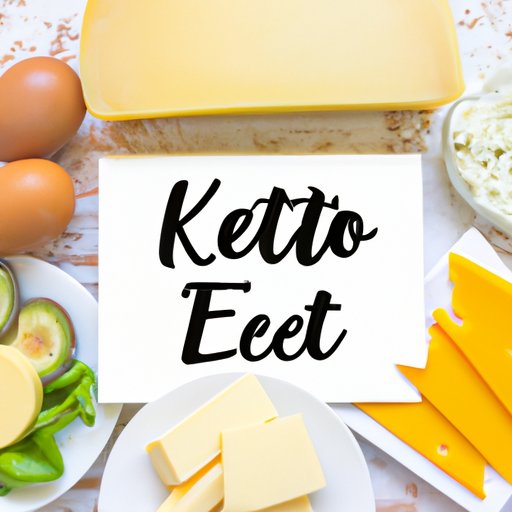
Introduction
Are you curious about the keto diet but unsure where to start? You’re not alone. This low-carb, high-fat diet has gained widespread popularity in recent years for its potential benefits, including weight loss, increased energy, and improved blood sugar control. In this article, we’ll provide a comprehensive guide to keto diet food components, explore the science behind ketosis, and offer practical tips for meal planning and recipe ideas.
An Ultimate Guide to Understanding the Keto Diet and its Food Components
The keto, or ketogenic, diet is a high-fat, low-carbohydrate eating plan that aims to put the body into a state of ketosis. This metabolic state is achieved by consuming less than 50 grams of net carbs per day, which forces the body to burn fat for fuel instead of glucose.
The main food components of the keto diet are protein, fats, and carbs. Unlike other low-carb diets that focus on high protein intake, the keto diet encourages moderate protein consumption to prevent the body from breaking down muscle tissue for energy.
What Foods Can You Eat on a Keto Diet? Complete List
A keto diet typically consists of nutrient-dense whole foods such as meat, seafood, non-starchy vegetables, and healthy fats. Some examples of keto-friendly foods include:
– Grass-fed beef
– Poultry
– Seafood (especially fatty fish like salmon and tuna)
– Leafy greens and cruciferous vegetables (e.g. spinach, broccoli, cauliflower)
– Avocado and other low-carb fruits (e.g. berries)
– Nuts and seeds
– Full-fat dairy (e.g. cheese, butter, cream)
Foods that are restricted on a keto diet include grains, sugar, and most fruit. This is because these foods contain high amounts of carbohydrates that can quickly kick the body out of ketosis. However, some low-carb fruits like berries can be incorporated in moderation.
When grocery shopping for a keto diet, it’s important to read labels carefully and choose whole, minimally processed foods. Pre-packaged foods may contain hidden sources of sugar or other carbs that can sabotage your efforts.
Exploring the Science Behind the Magic of Keto Foods
When the body enters into ketosis, it shifts from burning glucose for energy to burning stored fat. This process produces ketones, which are used by the brain and other organs for fuel.
Beyond weight loss, some potential benefits of a keto diet include improved insulin sensitivity and reduced inflammation. However, it’s important to note that long-term studies on the safety and efficacy of a keto diet are limited. Additionally, some people may experience negative side effects such as constipation or headaches.
Easy and Delicious Keto Recipes – How to Make the Most of Your Diet
One of the biggest challenges of a keto diet is finding meals that are both satisfying and compliant with the guidelines. However, there are many simple and delicious keto recipes that can liven up your meal plan.
Some examples of keto-friendly recipes include:
– Cauliflower rice bowls with grilled chicken and avocado
– Creamy mushroom and spinach frittata
– Taco stuffed avocados
– Low-carb zucchini lasagna
– Chocolate avocado mousse
When cooking keto meals, it’s important to focus on healthy sources of fats such as coconut oil, olive oil, and avocado oil. These oils can add flavor and richness to dishes without adding unhealthy trans fats or refined carbohydrates.
The Pros and Cons of Following the Keto Diet – Everything You Need to Know
Like any diet, the keto diet has both potential benefits and drawbacks. Some benefits include:
– Rapid weight loss
– Improved insulin sensitivity and blood sugar control
– Reduced inflammation
However, some potential drawbacks include:
– Difficulties with adherence and sustainability
– Negative side effects such as digestive issues or muscle cramps
– Limited food choices and potential nutrient deficiencies
Before starting a keto diet, it’s important to speak with a healthcare professional to ensure that it’s safe and appropriate for your individual needs.
The Best Keto Meal Plans and Snacks for Busy People on-the-go
Maintaining a keto diet while on-the-go can be especially challenging, but there are many options for quick and convenient keto meals and snacks. Some examples include:
– Meal replacement shakes or bars
– Pre-packaged keto snacks (e.g. nuts, beef jerky)
– Fast food options (e.g. bunless burgers, grilled chicken)
It’s also important to prepare for travel or dining out by researching menu options ahead of time and packing snacks or meals as needed.
Keto for Beginners: How to Kickstart Your Journey to a Healthier Lifestyle
If you’re new to the idea of a keto diet, it can seem overwhelming at first. However, with some practical advice and encouragement, you can begin your journey to a healthier lifestyle.
Some tips for starting a keto diet include:
– Gradually reducing carb intake over time to avoid feeling overwhelmed
– Tracking your intake and progress with a food diary or app
– Finding support through online communities or a healthcare professional
It’s also important to focus on long-term success rather than short-term weight loss, and to pursue a balanced and sustainable approach to health and nutrition.
Conclusion
The keto diet can be a powerful tool for improving health and wellbeing, but it’s not without its challenges. By understanding the science behind ketosis, making smart food choices, and seeking support from healthcare professionals and online communities, you can set yourself up for success. Remember to prioritize balance and sustainability, and celebrate your progress along the way.




